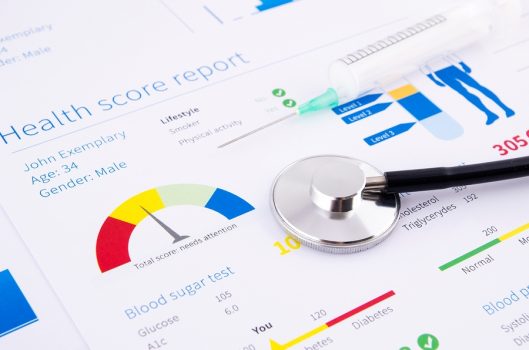
Health factors like blood pressure and cholesterol readings are an important part of designing a fitness program that is safe and effective.
Your blood pressure changes from day to day and even from moment to moment. For instance, it rises when you are active or excited and goes down when you rest or sleep. This is quite normal and nothing to worry about. In some people, however, blood pressure goes up and stays that way. When this happens, the person is said to suffer from high blood pressure.
What is Normal?
Blood pressure is measured at two phases of the heart’s action. One is when the heart is contracting. This is called “systolic” pressure. The other is when the heart is relaxing between beats. This is called “diastolic” pressure. Normal systolic blood pressure is about 120 and normal diastolic about 80. Your blood pressure is recorded with the systolic reading over the diastolic. For example, the reading above would be shown as ” 120 over 80″ or 120/80. In determining whether a person has a high blood pressure problem or not, doctors usually focus on the diastolic reading. People whose diastolic blood pressure stays at 90 or above, in repeated tests at different times, are usually considered to have some degree of high blood pressure.
Checklist for Blood Pressure Control
- Have your blood pressure checked regularly. Your primary care physician can tell you how often.
- Stop smoking.
- Avoid excessive salt intake.
- Eat more fresh fruits, vegetables, and foods high in fiber…and less fat.
- Reduce stress on and off the job; master relaxation techniques.
- Be moderate in your drinking.
- Exercise regularly and be sure to follow specific exercise guidelines for high blood pressure, and keep your weight within normal limits. If your doctor prescribes medication to lower your blood pressure, be sure to follow their directions exactly.
The Lowdown on Blood Pressure
Blood pressure is the force of the flowing blood against the walls of the arteries. It’s measured in two numbers. For for example, ‘140/90.’ The first number (140) is systolic pressure, the pressure when the heart contracts and pumps the blood through the body. The lower number (90) is diastolic pressure, the pressure between pumps, when the heart is resting 120/80 is considered normal. You may have high blood pressure (hypertension) if your blood pressure reading is equal to or greater than 140/90 for extended periods of time. Elevated blood pressure means your heart is working harder than normal, putting both your heart and arteries under a greater strain.
Only your doctor is qualified to diagnose whether you have high blood pressure or not.
How to Keep High Blood Pressure Under Control:
If you are diagnosed with high blood pressure, it’s extremely important that you follow your doctor’s treatment guidelines to the letter. These guidelines include keeping your diet low in fat, reducing your salt intake, quitting smoking, and limiting your alcohol consumption. In addition, you should exercise regularly, keep your weight within normal bounds, and learn to manage stress (instead of letting it manage you). Some recent research suggests that constant stress and pressure may predispose some men to continually elevated blood pressure later in life.
Cholesterol:
Cholesterol is only found in animal fats. It is essential in making sex hormones, and bile acids A blood level of less than 200 mg. is desirable. Although cholesterol is a fat, no calories are derived from it, because the body cannot break it down. You should limit yourself to no more than 300 milligrams of cholesterol a day.
Cholesterol is a waxy, fat-like substance (lipid). Although it’s often discussed as if it were a poison, it performs many essential bodily functions. “Cholesterol” is often a catch-all term for both the cholesterol you eat and the cholesterol in your blood. Cholesterol exists in food as a dietary lipid. You’ll find cholesterol only in animal products, such as meat and dairy foods. Cholesterol also exists in a different way as a natural component of your blood lipids. The cholesterol in your blood comes both from your liver and from the foods you eat. Your liver makes about 80 percent of your blood cholesterol.
Bad Cholesterol:
VLDLs convert to LDLs which are used by the body and removed. However, some people’s systems remove LDLs too slowly which causes LDLs to rise in the bloodstream. This slow tendency is hereditary! When the LDL blood levels become too high, the body tends to start depositing cholesterol and other fatty substances in artery walls. LDLs have, therefore, been called “the bad cholesterol” since they’re the cause of heart disease. When LDLs line the arteries, they cause atherosclerosis and start slowing the blood supply to vital organs.
Good Cholesterol:
HDL or ‘good cholesterol,” serve as the bloodstream’s “scavengers,” literally vacuuming up cholesterol and carrying it back to the liver to make into new VLDL or to remove it from the body via bile acids. HDLs, by removing cholesterol from the blood, decrease cholesterol damage to the arteries. The higher your HDL cholesterol, the lower your risk of developing heart disease.
Triglycerides:
Triglycerides area a type of fatty substance in the blood. Blood triglycerides levels tend to be elevated in people who have high cholesterol levels, especially in people who are obese, or those with chronic kidney disease or diabetes. Some studies suggest that high blood triglycerides might increase the risk of heart disease. But other research fails to link high triglycerides levels with heart disease. Ask your physician about therapy to lower your triglycerides. Dietary changes and weight loss can help most people or sometimes medication may be necessary to lower the triglycerides levels.
The Lower Your Ratio, the Lower Your Risk of Heart Disease
Improve your total cholesterol/HDL ratio by lowering your LDL cholesterol level, while raising your HDL level! You want to strive for an HDL level of 65 mg/dl or over. HDLlevels can be raised significantly by exercising, not smoking and leanness. Exercising regularly may also lower LDL cholesterol.
Contact Chicago Personal Training to get started on your fitness program;
Call 847-772-3487 or click on the link below for more information.
